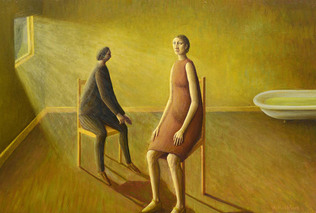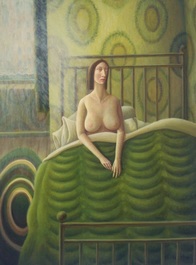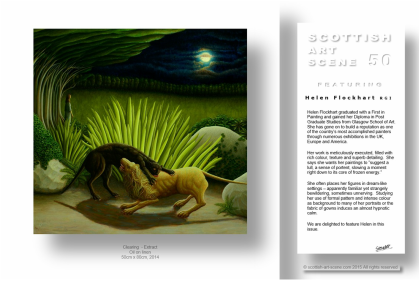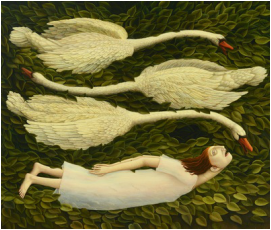HELEN FLOCKHART
Words About Pictures
Press for "Beasts" in Arusha Gallery 26 November - 20 December 2020:-
Review by Mark Brown for the Sunday National: https://scottishstage.wordpress.com/2020/11/30/review-beasts-by-helen-flockhart-and-beth-carter-arusha-gallery-edinburgh/
Article by Jan Patience in the Herald 23 November 2020: www.heraldscotland.com/news/18892553.galleries/
Article by Susan Mansfield in Scottish Art News: https://flemingcollection.com/scottish_art_news/news-press/helen-flockhart-beasts
Article in The Edinburgh Reporter about "Beasts" in Arusha Gallery 4 November 2020:
theedinburghreporter.co.uk/2020/11/arusha-gallery-to-present-beasts-by-helen-flockhart-with-work-from-beth-carter/
Article in Art Thou by Alice Keeling: www.ArtThou.co.uk/editorial/beasts-at-arusha-gallery
Review by Mark Brown for the Sunday National: https://scottishstage.wordpress.com/2020/11/30/review-beasts-by-helen-flockhart-and-beth-carter-arusha-gallery-edinburgh/
Article by Jan Patience in the Herald 23 November 2020: www.heraldscotland.com/news/18892553.galleries/
Article by Susan Mansfield in Scottish Art News: https://flemingcollection.com/scottish_art_news/news-press/helen-flockhart-beasts
Article in The Edinburgh Reporter about "Beasts" in Arusha Gallery 4 November 2020:
theedinburghreporter.co.uk/2020/11/arusha-gallery-to-present-beasts-by-helen-flockhart-with-work-from-beth-carter/
Article in Art Thou by Alice Keeling: www.ArtThou.co.uk/editorial/beasts-at-arusha-gallery
Press for Linger Awhile, Solo Show at Arusha Gallery 14 September - 7 October 2018
Review by Susan Mansfield in The Scotsman 29 September 2018
https://www.pressreader.com/uk/the-scotsman/20180929/282398400348701
Article in The Herald by Jan Patience 15 September 2018
https://www.heraldscotland.com/arts_ents/16867996.artist-helen-flockharts-compelling-works-tell-tragic-story-of-mary-queen-of-scots/
Article in Scotland on Sunday by Brian Ferguson 26 August 2018
https://www.scotsman.com/lifestyle/new-mary-queen-of-scots-portraits-to-grace-her-birthplace-1-4789821
Kirsteen Paterson in The National 7 September 2018
4789821http://www.thenational.scot/news/16694237.Artist_offers_fresh_perspective_on_Mary_Queen_of_Scots__tragic_life/?
Press Release for Linger Awhile:
Helen Flockhart: Linger Awhile 14 September - 7 October 2018
Preview: Thursday 13 September, 6-8pm
The legendary events and personal tragedies that marked the life of Mary, Queen of Scots will be the subject
of a new exhibition in Edinburgh this autumn. Linger Awhile, which will open on 14 September at Arusha
Gallery, will include 17 new oil paintings by Glasgow-based artist Helen Flockhart, focusing on the human
side of the historical figure.
Helen Flockhart (b.1963) is one of the finest and most distinctive Scottish artists of her generation. She often
draws creative inspiration from esoteric and mythical sources, and her unique style combines intricate
patterns, backdrops of lush foliage, and surreal scenes that appear suspended in time.
The works in Linger Awhile stem from Flockhart’s fascination with the controversies, legends and divided
opinions — even among today’s historians — that surround the figure of Mary, Queen of Scots. The minutely
painted scenes and colourful portraits weave myths with historical facts, and feature Mary, recognisable with
her auburn-red hair and near six foot-tall stature, as a woman filled with hopes and aspirations. Fittingly, the
exhibition will travel to Linlithgow, the birthplace of Mary, from October 2018 to January 2019, after the
Edinburgh show.
Mary Stuart, often called Mary, Queen of Scots was a controversial figure. Born in 1542 at Linlithgow Palace
Scotland, she spent her childhood in France and married the Dauphin of France, Francis, in 1558. After his
death in 1560, she returned to Scotland and married her first cousin, Lord Darnley, with whom she had a
son, James I/VI, in 1566. Darnley was assassinated in 1567, and quickly afterwards Mary married the Earl of
Bothwell — her alleged lover and assassin of Darnley. Their union was contentious, as many believed the
couple was implicated in Darnley’s murder; it was followed by an uprising which led to Mary’s imprisonment
at Loch Leven Castle, before she was forced to abdicate in favour of her infant son. She escaped in 1568
and fled to England, seeking the protection of her cousin Queen Elizabeth. However Mary was still
considered by many the legitimate sovereign of England and, as a result, a threat for Elizabeth, who kept her
in custody in various castles and manor houses for the next 19 years. Elizabeth eventually ordered her
beheading in 1587, after Mary was found guilty of plotting to assassinate her
The painting Linger Awhile, after which the exhibition was titled, explores childhood innocence and Mary’s
first wedding. She and Francis, only 15 and 14 at the time, are shown curled up in an affectionate embrace,
almost engulfed in crumpled bedding and lace from her petticoat. The tender scene evokes a dream-like
sense of peace and comfort, while bright tumbled wild flowers recall the abandonment and carelessness of
youth.
Here Flockhart wonders what Mary, not unlike Faustus giving the devil his soul in exchange for worldly
pleasures, would have given to remain in this idyllic stage of life. Intricate patterns of Scottish thistle, French
fleur de lys and Tudor rose form the lace of her dress, as if the symbolism of history was an integral part of
her outfit, already a nod to the historical events that would ultimately lead to her death.
As well as ominous castles, Flockhart often includes lush gardens of alluring strange beauty in her work, with
details so intricate they can take several months to be completed. In the portrait Indian Summer she shows
Mary in the final autumn of her life, a season described in historical accounts as unseasonably mild and a
time when Mary reached a stage of serenity, seemingly not tormented by her imminent death. Flockhart
combines symbolic significance and emotional intensity, the ripe fruit and luxuriant vegetation suggesting
vibrant life and inner peace. Yet the figure’s yellow and orange dress remains ambiguous: the swirling motifs
suggest a sense of internal tumult, and hint at the bonfire from contemporary representations of her death,
where her belongings were burnt to prevent supporters keeping them as relics.
In Lover’s Eye, the motif on the dress is repeated like a wallpaper pattern: Mary is shown escaping Loch
Leven Castle, pushing a bark carrying two small figures — a reference to her miscarrying twins during her
time at the castle. As well as using Mary’s dress as a medium for historical references, Flockhart literally
weaves the legend of Mary into her own outfit.
In Lachrymose Window, Mary’s dress is similarly heavy with narratives: Queen Elizabeth, a banner from the
Scottish battle of Carberry Hill, the Scottish minister John Knox as a crow, and a dolphin for Mary’s first
husband Francis, are all part of the detailed embroidery. There is also the reproduction of an inflammatory
poster used after hers and Bothwell’s marriage, showing a hare and mermaid: the former a hint to his
family’s coat of arms, the latter the symbol of a prostitute. Wearing her own legends, the images so jumbled
up it is impossible to tell facts from tales, Mary sits patiently by a window covered in thick fern and ivy: a nod
to the 19 years she spent incarcerated by Queen Elizabeth.
Helen Flockhart commented: “Immersing myself in the story of Mary, Queen of Scots plunged me into an
imaginative place filled with such rich imagery that it propelled me through a whole year. I became
particularly interested in the way her gender impacted on the events of her life and ultimately her death, and
the strands which weave together to form the legend. ”
THE PAINTINGS OF HELEN FLOCKHART
The purpose of art is not to reflect the visible, but to make the invisible visible. - Paul Klee
Nobody paints like Helen Flockhart. In a contemporary art world where the autobiographical and the pastiche are everywhere, Helen Flockhart paints pictures which are personal and unique; and, at the same time, enthralling and universal. Through the transforming power of her vivid imagination the poetic art of Helen Flockhart creates a fascinating visual world that is familiar and fantastic, lost and found again. As in our dreams we both lose and simultaneously find ourselves in this magical realm of other existence. Here the mundane and the mythical are at one with each other. Yet there is no illusionism involved. Nothing is veiled or hidden from our intense gaze as we are openly invited to absorb and pour over the intricately painted patterns of decorative design, and the scrupulously worked surfaces of descriptive detail. All this excessive display takes place within an enclosed fabulous domain where every action and expression is redolent with symbolic significance and emotional intensity. As with the art of Paul Klee, Helen Flockhart's paintings reveal a world of alluring strange beauty which for those of us who enter - can disturb, enthrall and yet console - our distracted lives in these troubled times.
Bill Hare 2011
Honorary Teaching Fellow in Modern and Contemporary Scottish Art, The University of Edinburgh.
THE PAINTINGS OF HELEN FLOCKHART
The purpose of art is not to reflect the visible, but to make the invisible visible. - Paul Klee
Nobody paints like Helen Flockhart. In a contemporary art world where the autobiographical and the pastiche are everywhere, Helen Flockhart paints pictures which are personal and unique; and, at the same time, enthralling and universal. Through the transforming power of her vivid imagination the poetic art of Helen Flockhart creates a fascinating visual world that is familiar and fantastic, lost and found again. As in our dreams we both lose and simultaneously find ourselves in this magical realm of other existence. Here the mundane and the mythical are at one with each other. Yet there is no illusionism involved. Nothing is veiled or hidden from our intense gaze as we are openly invited to absorb and pour over the intricately painted patterns of decorative design, and the scrupulously worked surfaces of descriptive detail. All this excessive display takes place within an enclosed fabulous domain where every action and expression is redolent with symbolic significance and emotional intensity. As with the art of Paul Klee, Helen Flockhart's paintings reveal a world of alluring strange beauty which for those of us who enter - can disturb, enthrall and yet console - our distracted lives in these troubled times.
Bill Hare 2011
Honorary Teaching Fellow in Modern and Contemporary Scottish Art, The University of Edinburgh.
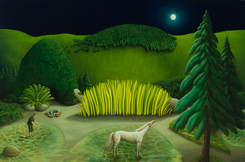 "Shallows", 102cm x 152ccm, oil on linen, 2017
"Shallows", 102cm x 152ccm, oil on linen, 2017
Artist's statement about "Shallows" in the Columbia Threadneedle Prize Exhibition 2018: columbiathreadneedleprize.mallgalleries.org.uk/browse-and-buy/shallows
Review of solo show "In the Morning it is Green" by Bill Hare in The List 14 June 2017:
www.list.co.uk/article/92146-helen-flockhart-in-the-morning-it-is-green/
www.list.co.uk/article/92146-helen-flockhart-in-the-morning-it-is-green/
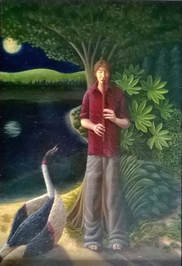
Jan Patience has written about "Low Whistle" and the Past and Present Elected RGIs Show in the Lillie Gallery in The Herald on 3 September 2016
http://www.heraldscotland.com/arts_ents/14721197.RGI_finds_its_feet_in_Milngavie/?ref=rss
http://www.heraldscotland.com/arts_ents/14721197.RGI_finds_its_feet_in_Milngavie/?ref=rss
Interview with Janet McKenzie in Studio International February 27 2015
http://www.studiointernational.com/index.php/helen-flockhart-interview-painter-glasgow-school-of-art
http://www.studiointernational.com/index.php/helen-flockhart-interview-painter-glasgow-school-of-art
Article in the Sunday Herald about artists for whom gardening is an influence on their work 24 January 2016
http://www.heraldscotland.com/arts_ents/14226322.Painting_the_modern_garden__the_Scottish_artists_propagating_masterpieces_among_the_blooms/
http://www.heraldscotland.com/arts_ents/14226322.Painting_the_modern_garden__the_Scottish_artists_propagating_masterpieces_among_the_blooms/
|
Artist's statement in Scottish Art Scene Magazine on two paintings in "Allusion" at RGI Kelly Gallery October 2015 http://scottish-art-scene.com/RGI_Allusion_&_Connections.pdf
By their nature paintings express that which cannot be said, otherwise what is the point? Words are a poor second in my hands, painting is its own language. As far as the story telling analogy goes, I would not say that my paintings have a beginning, a middle and an end. During the process of building the picture a world emerges which has its own logic. In this sense poetry is possibly a closer parallel. I try to harness the core of a moment, urgently conceived and recorded then deliberately executed: taking an essence, pinning it down and spreading it out on canvas/the surface. It is often only afterwards, looking at the finished work, that I can make order out of something which is fluid. The starting point for both of these paintings was the colour yellow. In "Yellow Room" the combination of acid and hot yellow have associations with sodium vapour street lights and the barley sugar doled out to ward off nausea in childhood car journeys. Outside light provides relief as it spills through and fills the thick air within. The bath is cool and clean. It is necessary, but its presence spoils the comfort. In "Eiderdown" light from the window pierces the tired yellow of the walls and busy pulsing pattern, beckoning to a clear, fresh world without. The two sets of figures in these paintings are close in physical proximity but do not interact. Helen Flockhart |
Gallery statement for "Nocturne", solo exhibition at Rebecca Hossack Gallery, London 2 September - 3 October 2015
http://www.rebeccahossack.com/exhibitions/109/overview/
http://www.rebeccahossack.com/exhibitions/109/overview/
Matthew Sturgis on "Canute" in "Inspired" THE FLEMING COLLECTION
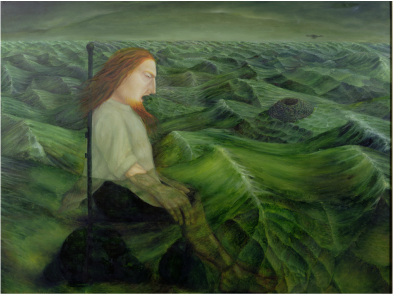 Canute, 114.2cm x 144.7cm, oil on canvas, 1997, Fleming Collection Canute, 114.2cm x 144.7cm, oil on canvas, 1997, Fleming Collection
"The mediaeval chronicler Henry of Huntingdon provides the earliest record of King Canute's memorable encounter with the waves. The act, it seems, was not motivated by royal pride but a sense of Christian humility. As Canute sat enthroned on the seashore, the incoming tide washing over his feet, he proclaimed to his courtiers the limits of temporal kingship, and the true greatness of God - who alone could command the waters.
Helen Flockhart's luminous painting is clearly not a mere illustration of Henry of Huntingdon's chronicle. It is something more. Here red-haired King is alone, no shore in sight, the green waves rising towards his chest. He seems locked in a solitary contest or dialogue with the deep. With brow set, he leans into the swell, perhaps striving against the tide, or perhaps seeking to become part of it. The meticulous details, the exquisite craftsmanship, the gem-like quality of the light, all add to the concentrated energy of the image. There is a sense of yearning and pathos: of Man's desire to become, once again, subsumed into the wholeness of Nature" Matthew Sturgis is a writer and historian. "Inspired" was published in 2010 by the Trustees of the Fleming-Wyfold Foundation Interview in Scottish Art Scene Magazine http://scottish-art-scene.com/Helen_Flockhart.pdf |
Article by Jan Patience in The Herald on "Swan Like" in Compass Gallery, September 2013:
http://www.heraldscotland.com/arts-ents/visual/helen-flockharts-solo-show-is-in-fine-feather.1379732407
